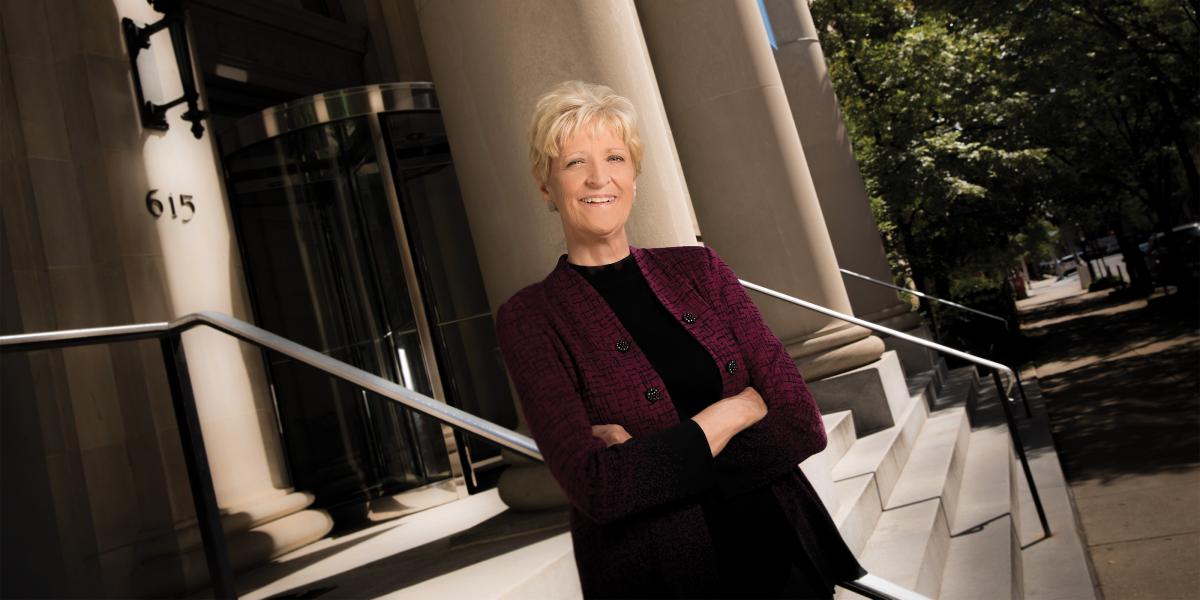Our Baltimore
The health of our hometown is a strategic and moral imperative for our School.
Baltimore changed my life.
I came here in 1972 to pursue graduate education at the School and never left. I launched my career, met my husband, and started my family here. Now when people ask me where I’m from, I say Baltimore. Yes, I was brought up in New York and went to college in New Jersey—still, Baltimore is my home. And more than ever before, as dean of the Bloomberg School, I am excited about the future of this great city steeped in history and full of hope and opportunity.
When I gathered my colleagues last year to draft a new strategic plan for the School, we found one constant. In meetings with hundreds of students, faculty, staff, alumni, and community members, we discussed dozens of topics as narrow as a malaria vaccine and as broad as planetary health. The topic that popped up again and again? Baltimore.
Longtime Baltimore residents and students just passing through came together in support of aligning the School’s efforts with the health and vitality of our hometown. That’s why one of the strategic plan’s main themes—the power of partnerships—emphasizes “a special commitment to Baltimore.”
This commitment emerges from a complicated history. Over the years, our School and our city have teamed up to achieve major advances in public health by implementing and evaluating evidence-informed policies and programs. Together, we have taught the world how to improve water quality, address tuberculosis, reduce opioid-related deaths, and lower infant mortality.
Yet there have also been times when the School fell short on meeting the promise of public health and the potential of this city. As School historian Karen Kruse Thomas has documented in her history of the School from 1935 to 1985, Health and Humanity, these problems included a series of intrusive door-to-door surveys that prioritized data collection over sensitivity to community needs and priorities, undermining community trust and leading to a major rupture with the Baltimore City Health Department in the late 1940s.
Looking forward, we’re committed to a range of participatory research projects, mutually beneficial collaborations, and support for key city strategies.
What does our renewed commitment to Baltimore look like? Projects informed by community needs and infused with community-based solutions. The School’s Center for Communication Programs, which has important work going on around the city as well as the world, has a wonderful credo: Learn to listen, listen to learn. After listening for years about the need for jobs in East Baltimore, Jeff Leek responded by training people in East Baltimore in data science so they could get good jobs (see Heads in the Cloud). And consider the research into the links between housing and health led by our faculty and documented in this issue’s cover article (see Home: A Story in Three Parts). These efforts emphasize the growing importance of deep partnerships with sectors both inside and outside the traditional boundaries of public health.
Another great example of the School’s engagement with Baltimore: The SPARC Center. Led by Susan Sherman, SPARC is dedicated to helping marginalized women who are engaged in sex work or other aspects of the street economy. Based on their input, this harm-reduction Center provides showers, a laundry, and a range of medical, legal, and social services.
To turn the tide of infant mortality in Baltimore, CCP joined with the city health department to communicate vital guidance about safe sleep that led to a 36% reduction in infant deaths. To fight stigma associated with HIV and encourage more people who are substance users to get treatment, the Lighthouse helped neighbors become peer advocates.
We are also leveraging our expansive global footprint by working with colleagues around the world to help communities right here in Baltimore. With funding from the Bloomberg American Health Initiative, we are developing a model toolkit aimed at strengthening partnerships between academic institutions and communities in both Kampala and Baltimore.
And then there is SOURCE, the community engagement and service-learning center working with Baltimore and the schools of public health, nursing, and medicine.
For nearly 15 years, SOURCE has matched the needs of community organizations with faculty, students, and staff eager to help and to learn. In the past five years alone, SOURCE has helped more than 7,000 Johns Hopkins volunteers spend more than 215,000 hours supporting our communities. Driven by deeply held values of reciprocity, social justice, and collaboration, the organization spends time developing relationships and understanding needs in order to found mutually beneficial partnerships.
SOURCE volunteers have supported the House of Ruth, a domestic violence center, in developing curricula about preventing intimate partner violence. Volunteers have worked with the Shepherd’s Clinic, which provides health care for the uninsured, to write grants to secure much-needed funds. Every week, SOURCE volunteers help the Living Classrooms Foundation run an Identity Clinic that helps people returning from prison get a birth certificate or state identification and knock down other barriers to getting a job or signing a lease.
SOURCE and the work of our faculty, staff, and students demonstrate our steadfast commitment to the health and well-being of our city. Recently, the Association of Schools & Programs of Public Health led a site visit to Baltimore to consider our School for the Harrison C. Spencer Award for Outstanding Community Service. More than two dozen of our community partners participated. Seeing the mutual appreciation and respect on this site visit was humbling and inspiring.
The award now sits in my office—as a marker of both the progress we’ve made and the work yet to be done.
